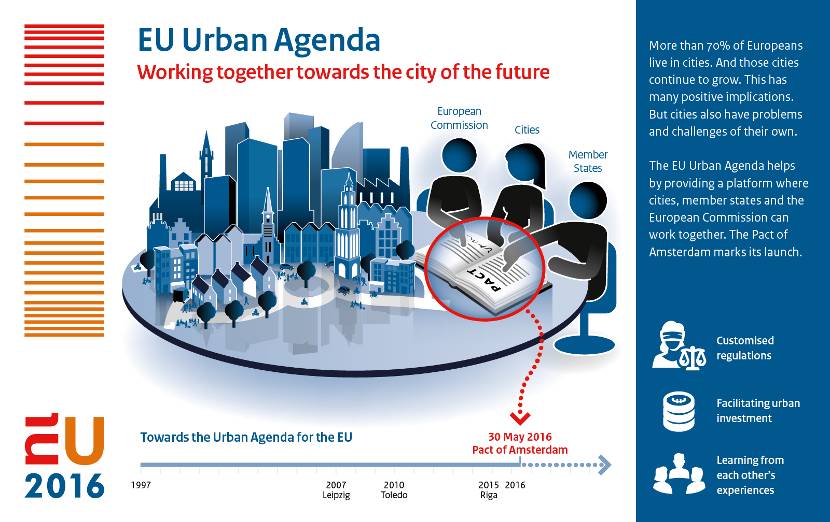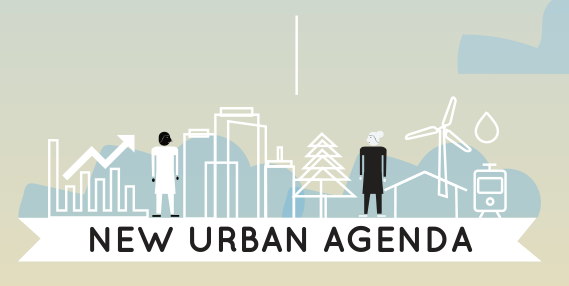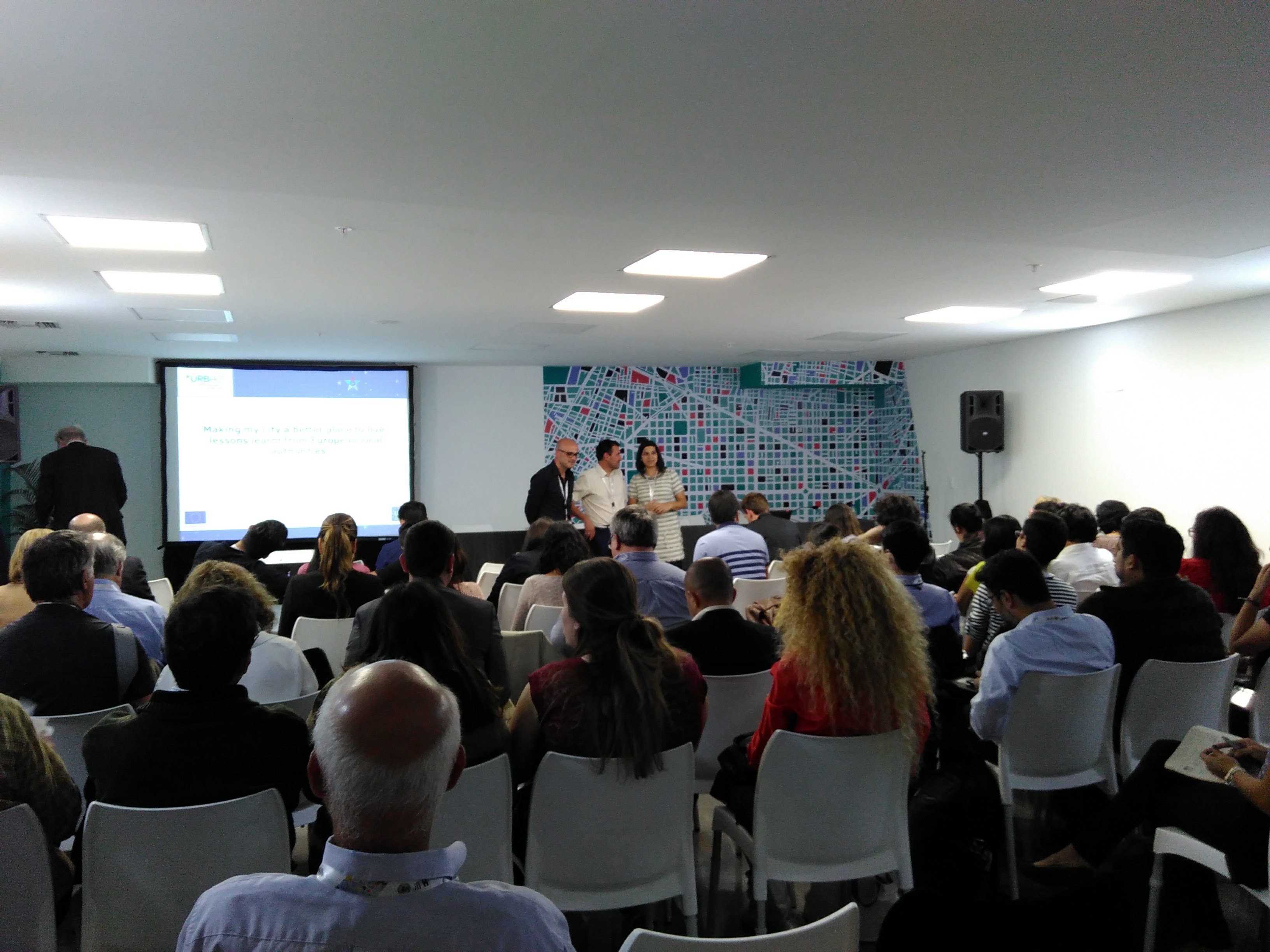Take-aways from HABITAT III and the New Urban Agenda
Edited on
24 June 2019
Read time: 6 minutes
If you have somewhere somehow heard about HABITAT III and New Urban Agenda here is a short overview of what they actually mean for the future of urban development in the world.
Habitat III was the United Nations Conference on Housing and Sustainable Urban Development that took place in Quito, Ecuador, on 17-20 October 2016 gathering 30,000 people from 167 countries. The conference reinvigorated the global commitment to sustainable urbanization and Member States of the United Nations adopted a New Urban Agenda, building on the Habitat Agenda of Istanbul in 1996.
URBACT was present to demonstrate the need, value and importance of territorial cooperation and bring back the highlights of the conference and the New Urban Agenda.

What is the New Urban Agenda about?
Simply put, the New Urban Agenda is a 22-page document intending to “guide the next twenty years of sustainable and transformative urban development worldwide”. The New Urban Agenda is an agreement amongst Member States of the United Nations, a shared vision on the future of our cities and rough commitments for sustainable urban development.
A shared vision
Five points and many more sub-points enumerate a shared vision for cities and human settlements for all, a vision where “all inhabitants without discrimination of any kind are able to inhabit and produce just, safe, healthy, accessible, affordable, resilient and sustainable cities”.
This vision includes equal rights and opportunities, fundamental freedoms, adequate housing, equal access for all to public goods, civic participation and engagement, gender equality, accessible urban mobility, disaster management and resilience, environmental sustainability, high productivity, competitiveness and innovation by promoting full and productive employment and decent work for all.
Commitments
In the New Urban Agenda Member States are committed to work on:
- social inclusion and ending poverty
- urban prosperity and opportunities for all
- environmentally sustainable and resilient urban development
They also outline the conditions for effective implementation like setting-up policy frameworks at national, subnational and local levels; participatory planning ; international cooperation ; capacity-building and sharing of practices, policies and programmes amongst governments at all levels, but without any operational plan, targets or indicators to which Member States and other policy-makers are accountable.
While the document is meant to be universal in scope it is not binding in terms of implementation. The latter depends on the voluntary commitments Members States and urban stakeholders are willing to take and make visible in the Quito Implementation Plan.
Is the New Urban Agenda really new?
This is definitely debatable since the answer depends from one national and local context to another. While for some signing this Agenda may be a break-through, for some others this vision and principles are already considered as granted.
 In the European context for example, the integrated approach to urban development has a long history of European Union initiatives, policies and programmes like URBAN I and II focusing on deprived neighborhoods from 1994 to 2006 ; since 2002 the URBACT programme fostering integrated urban development through networking, capacity-building and knowledge-sharing among cities; the 2005 Bristol Accord on the importance of sustainable communities for Europe´s development; the adoption of the Leipzig Charter on Sustainable European Cities of 2007; the 2008 Marseilles Statement calling for the implementation of the Leipzig Charter principles by developing a common European Reference Framework for Sustainable Cities also known as RFSC ; the Lisbon Treaty of 2009 including the notion of territorial cohesion ; the Europe2020 strategy and the Cohesion Policy with the European Regional Development Fund ; and only recently the Pact of Amsterdam (30 May 2016) officially establishing the Urban Agenda for the EU.
In the European context for example, the integrated approach to urban development has a long history of European Union initiatives, policies and programmes like URBAN I and II focusing on deprived neighborhoods from 1994 to 2006 ; since 2002 the URBACT programme fostering integrated urban development through networking, capacity-building and knowledge-sharing among cities; the 2005 Bristol Accord on the importance of sustainable communities for Europe´s development; the adoption of the Leipzig Charter on Sustainable European Cities of 2007; the 2008 Marseilles Statement calling for the implementation of the Leipzig Charter principles by developing a common European Reference Framework for Sustainable Cities also known as RFSC ; the Lisbon Treaty of 2009 including the notion of territorial cohesion ; the Europe2020 strategy and the Cohesion Policy with the European Regional Development Fund ; and only recently the Pact of Amsterdam (30 May 2016) officially establishing the Urban Agenda for the EU. This perpetual search for identifying, setting and implementing the right principles, means and tools, testifies the complexity of urban problems, challenges and opportunities and the restless spirit of urban policy-makers to protect and sustain the “urban acquis” in times of economic crisis and the rise of new extreme political forces, orientations and decisions.
The New Urban Agenda itself resulted after many months of negotiations among Member States and series of consultations with key urban stakeholders across the world through preparatory committees, national, regional, and global reports, policy units, issue papers, informal hearings and meetings, intergovernmental meetings, regional and thematic meetings, e-discussions, world urban campaigns fora, you name it ! A preparatory machinery that started in September 2014 with the objective to assemble as many key urban stakeholders as possible in all over the world and take into account their voices in what is now adopted as the New Urban Agenda.
What came out of this admirably huge participatory approach has been an inclusive, consensual and sensitive-free document that anyone with common sense would agree on. Perhaps this is one of the weaknesses of the New Urban Agenda; the lack of unconventional and creative spirit, operational plan, targets, indicators, and way of working makes it more like a wishlist rather than an innovative and transformative agenda of the future.
Despite its weaknesses and the criticism one can exercise on the New Urban Agenda, we have to recognize that this has been a federative process and document and a reminder of the values we should all stand for and keep fighting for especially in times of global economic, environmental and societal challenges.
How to implement the New Urban Agenda?
Thousands of cities across the world have been implementing the principles of the New Urban Agenda and testing solutions and policies for many years now. Many answers and solutions already exist but are not always well known at a wide scale.
This is exactly where territorial cooperation can play a catalyst role. Cooperation, networking, interregional exchanges can scale up, transfer and adapt good practices and policies from one city to another. Why reinvent the wheel when national and local governments can learn from good practices and mistakes from other peers? Be it regional (e.g. pan-European) or international (e.g. amongst cities of different continents), territorial cooperation is the vehicle for cities to develop and eventually implement sustainable local policies.
 Take a city like Mollet del Vallès in Spain with 52 000 inhabitants for example. During HABITAT III, Mollet del Valles presented how they benefitted from exchanges with other European cities. Being part of the URBACT Diet for Green Planet network with Sodertalje (Sweden), Lomza (Poland) and Moletai (Lithuania), the city with no experience whatsoever in local food policies before decided to adapt the diet policy of the Sodertalje that was consisted of distributing healthy, balanced, organic, seasonal and locally produced food to all public canteens of the city. Mollet del Vallès gathered local producers, school teachers, cooks, dieticians, private companies, and politicians to discuss on how to improve the food quality and nutritional habits of people just as Sodertalje did. Together, they decided to change the public procurement model of the city introducing clauses for the companies distributing food in public canteens. These clauses include indicators and targets for tasty and healthy food; organically grown; less meat, more vegetables and wholegrain; seasonal food; locally produced; and reduced food waste. Mollet del Valles now delivers local and healthy cooked food to all the public canteens of the city and participates in the revitalisation of the local economy.
Take a city like Mollet del Vallès in Spain with 52 000 inhabitants for example. During HABITAT III, Mollet del Valles presented how they benefitted from exchanges with other European cities. Being part of the URBACT Diet for Green Planet network with Sodertalje (Sweden), Lomza (Poland) and Moletai (Lithuania), the city with no experience whatsoever in local food policies before decided to adapt the diet policy of the Sodertalje that was consisted of distributing healthy, balanced, organic, seasonal and locally produced food to all public canteens of the city. Mollet del Vallès gathered local producers, school teachers, cooks, dieticians, private companies, and politicians to discuss on how to improve the food quality and nutritional habits of people just as Sodertalje did. Together, they decided to change the public procurement model of the city introducing clauses for the companies distributing food in public canteens. These clauses include indicators and targets for tasty and healthy food; organically grown; less meat, more vegetables and wholegrain; seasonal food; locally produced; and reduced food waste. Mollet del Valles now delivers local and healthy cooked food to all the public canteens of the city and participates in the revitalisation of the local economy. See the video presenting the experience of Mollet del vallès in URBACT Diet for a Green Planet:

Basingstoke Council (UK) and Nantes (FR) also present in the HABITAT III conference, presented the benefits of being involved in city networks. Basingstoke with a population of 178 000 decided to join the URBACT ESIMEC network and work on how to connect local workforce skills to the needs of employers. Following transnational meetings with other European cities, master classes, and meetings with local stakeholders, employers, universities, city staff and young people, Basingstoke gained a real understanding of business needs and skills shortages at local level and decided to create “Basingstoke Employment and Skills Zone” to match education with the local business needs.
See the video presenting the results of the ESIMEC project:

Over the years URBACT has been responding to cities’ needs for networking with peers to get inspired, learn from each other, transfer and adapt good practices; for capacity-building of civil servants and local elected officials in participative planning and implementation of policies; for a bottom-up approach in the design and implementation of local policies with the creation of local groups; and for the use of results framework to monitor and evaluate results and impact of local policies.
Building on URBACT and other European Union programmes’ experience, the European Commission has decided to promote, reinforce and finance city-to-city cooperation at international level with the newly-created International Urban Cooperation programme. Starting from June 2017 and for at least three years, the European Commission will finance methodic networking between European cities and cities from Mexico, Argentina, Brazil, Chile, Colombia, Peru, Canada, China, India, Japan and the United States, with the objective to help them develop integrated local policies. This action-planning process should build on the URBACT methodology and experience.

In addition, the European commission has also committed to use the Urban Agenda for the EU to feed in the New Urban Agenda. Established on 30 May 2016 with the Pact of Amsterdam, the Urban Agenda for the EU, to which URBACT contributes, will focus on 12 Priority Themes such as: Jobs and skills in the local economy; Urban poverty; Housing; Inclusion of migrants and refugees; Sustainable use of land and Nature-Based solutions; Circular economy; Climate adaptation; Energy transition; Urban mobility; Air quality; Digital transition; and Innovative and responsible public procurement. Twelve partnerships each in charge of a topic and composed of Member States, cities and civil society organisations will deliver within three years action plans on better regulation (more effective, more efficient and implemented at a lower cost), better funding (more adapted to the needs, simpler access, more integrated) and better knowledge (data, good practices/ projects, exchange of experiences). Cross-cutting themes such as small and medium-sized cities, urban-rural linkages or innovative approaches should also be addressed.
Finally, the European Commission with the support of the OECD has committed to develop and test a global people-based definition of cities and settlements that could serve as a universal method of measurement of cities’ urbanisation.
Following up HABITAT III and the New Urban Agenda
 The New Urban Agenda already calls for a follow up and review of the commitments made by the Member States linked with the review of the 2030 Agenda for Sustainable Development. It invites the General Assembly of the United Nations to report on the progress of the implementation of the New Urban Agenda every four years.
The New Urban Agenda already calls for a follow up and review of the commitments made by the Member States linked with the review of the 2030 Agenda for Sustainable Development. It invites the General Assembly of the United Nations to report on the progress of the implementation of the New Urban Agenda every four years. This can be a challenging process considering the different commitments of the Member States and the lack of targets and harmonised indicators across countries. On the other side, it can trigger discussions on the need for a harmonised result framework across countries, hopefully well before the fourth United Nations Conference on Housing and Sustainable Urban Development in 2036 and the adoption of another new agenda.
URBACT will continue to closely follow the process and provide its experience, expertise and support in terms of city networking, knowledge-sharing, and capacity-building of urban stakeholders within and outside of Europe.
You can see pictures of URBACT at HABITAT III on the URBACT FLICKR here

